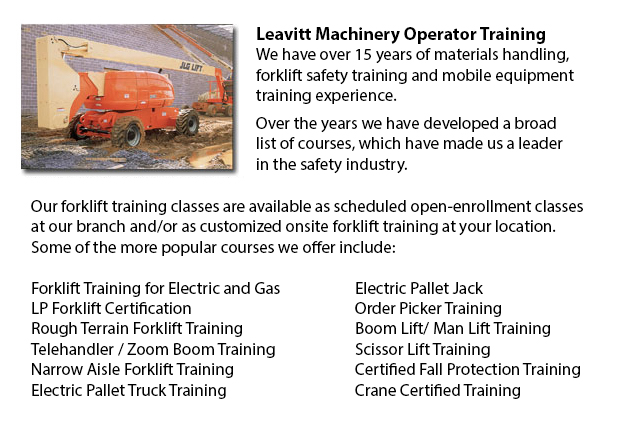
Guelph Aerial Boom Lift Ticket - Aerial platform lifts can accommodate various duties involving high and tricky reaching places. Sometimes used to carry out regular repair in buildings with high ceilings, trim tree branches, raise heavy shelving units or mend telephone cables. A ladder could also be utilized for some of the aforementioned projects, although aerial platform lifts offer more security and stability when properly used.
There are a handful of different designs of aerial forklifts available, each being capable of performing moderately unique jobs. Painters will sometimes use a scissor lift platform, which is able to be utilized to get in touch with the 2nd story of buildings. The scissor aerial lifts use criss-cross braces to stretch out and extend upwards. There is a table attached to the top of the braces that rises simultaneously as the criss-cross braces elevate.
Container trucks and cherry pickers are a different type of aerial lift. They contain a bucket platform on top of a long arm. As this arm unfolds, the attached platform rises. Lift trucks use a pronged arm that rises upwards as the lever is moved. Boom lifts have a hydraulic arm that extends outward and raises the platform. All of these aerial lift trucks require special training to operate.
Training courses offered through Occupational Safety & Health Association, known also as OSHA, embrace safety procedures, system operation, upkeep and inspection and device load capacities. Successful completion of these education programs earns a special certified certificate. Only properly qualified people who have OSHA operating licenses should operate aerial lifts. The Occupational Safety & Health Organization has formed guidelines to uphold safety and prevent injury when using aerial lift trucks. Common sense rules such as not utilizing this piece of equipment to give rides and ensuring all tires on aerial lifts are braced in order to hinder machine tipping are mentioned within the guidelines.
Unfortunately, statistics expose that more than 20 aerial hoist operators pass away each year when operating and nearly ten percent of those are commercial painters. The majority of these incidents were triggered by improper tie bracing, therefore some of these may well have been prevented. Operators should make certain that all wheels are locked and braces as a critical security precaution to prevent the machine from toppling over.
Marking the surrounding area with noticeable markers have to be utilized to safeguard would-be passers-by so that they do not come near the lift. What's more, markings should be placed at about 10 feet of clearance amid any utility cables and the aerial hoist. Lift operators must at all times be well harnessed to the hoist while up in the air.
-
Guelph Warehouse Forklift Training Classes
Guelph Warehouse Forklift Training Classes - Warehouse training classes exist for the reason of raising awareness regarding common warehouse hazards. Students learn the important safety procedures that are necessary to warehouse safety. An emphasis i... More -
Guelph Forklift Operator Certification
Guelph Forklift Operator Certification - Certification for forklifts are needed to guarantee the safe use of forklifts for those employers in construction, industrial and warehouse settings. The training has to involve a method of education plus some... More -
Guelph Crane Training School
Guelph Crane Training School - The crane training school offers industry-relevant programs. Courses provide trainees with learning results that match current industry demands. Our small class sizes combine hands-on experience and theory. Our qualifie... More -
Guelph Heavy Equipment Training Programs
Guelph Heavy Equipment Training Programs - At whatever given construction site, there are usually various kinds of machines that are ready to be used. These heavy and light equipment need both operators to run them and mechanics to fix them. Apprenti... More -
Guelph Skid Steer Ticket
Guelph Skid Steer Ticket - On a skid-steer loader, the lift arms are at the side of the driver together with pivot points at the back of the driver's shoulders. This makes them different compared to a traditional front loader. Because of the operator... More -
Guelph Zoom Boom Ticket
Guelph Zoom Boom Ticket - Zoom Boom Training focuses on correctly training prospective operators on variable reach forklifts. The training goals include gaining the understanding of the equipments physics and to define the tasks of the operator. This... More -
Guelph Heavy Equipment Training
Guelph Heavy Equipment Training - Commonly, the different types of heavy equipment training are divided into 2 categories of machinery: those that have rubber tires and tracked vehicles. Tracked vehicles consist of items like for instance bulldozers,... More -
Guelph Aerial Lift Safety Training
Guelph Aerial Lift Safety Training - Each year, there are roughly 26 construction deaths due to the use of aerial lifts. Nearly all of the craftsmen killed are laborers, electrical workers, carpenters, painters or ironworkers. Nearly all deaths are c... More

Forklift Certification Guelph
TOLL FREE: 1-888-254-6157
Guelph, Ontario
forkliftcertificationguelph.com
Email Us
About Us


